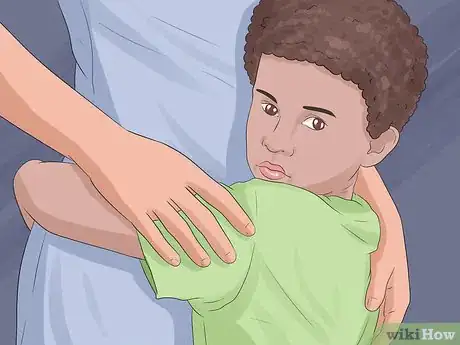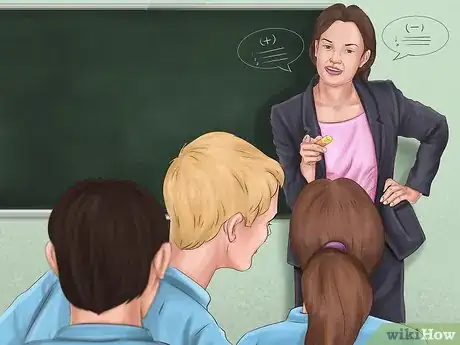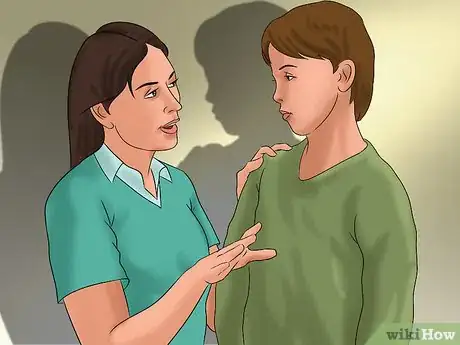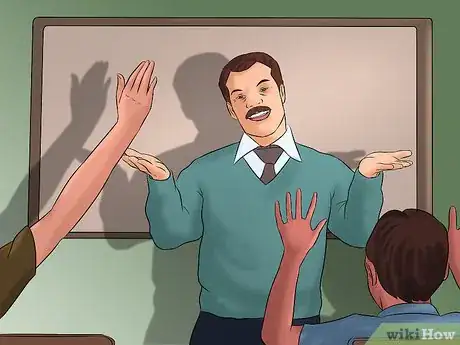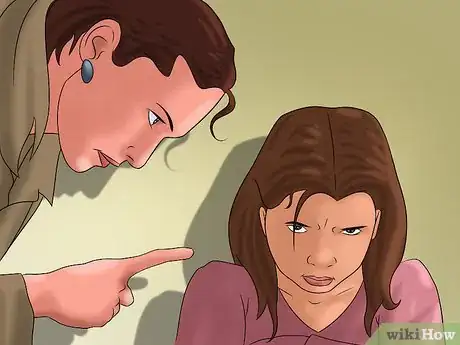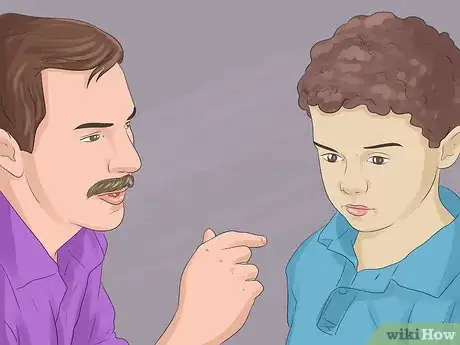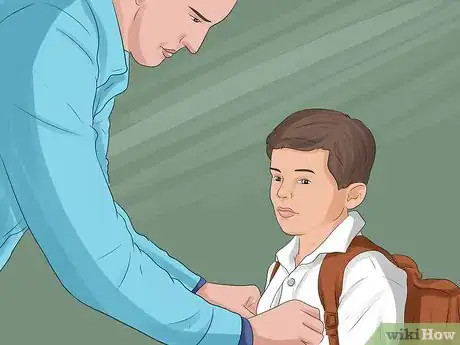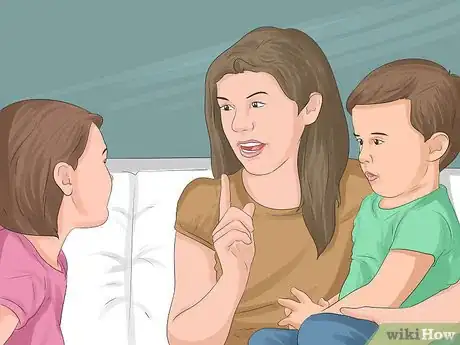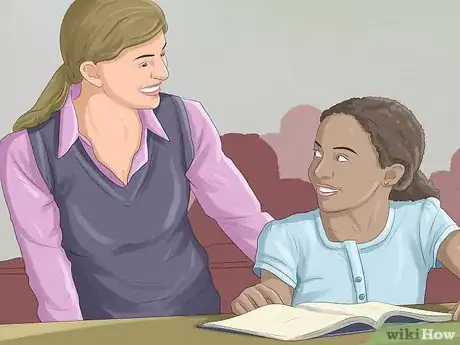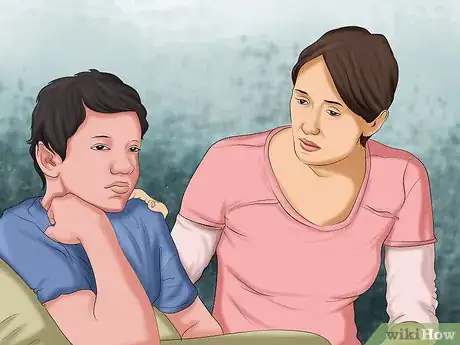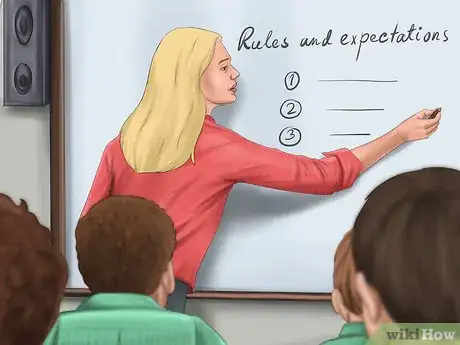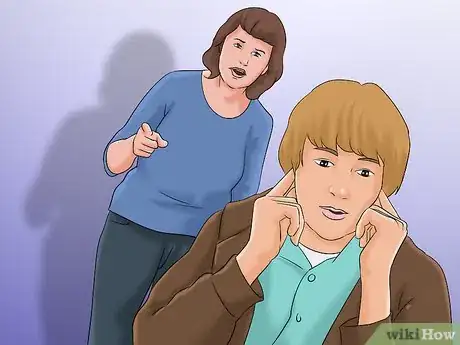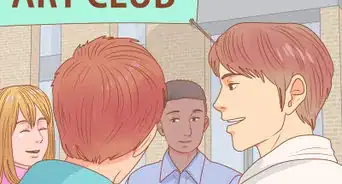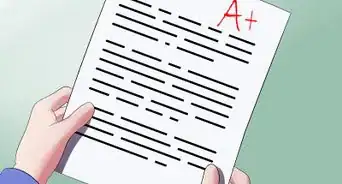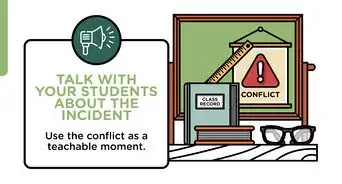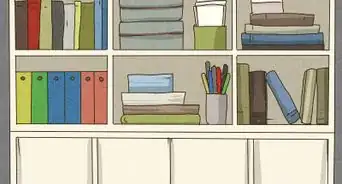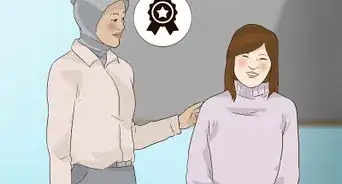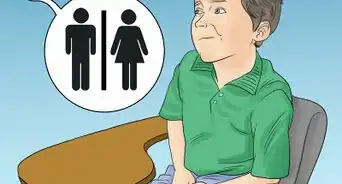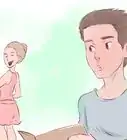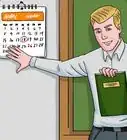This article was co-authored by Emily Listmann, MA. Emily Listmann is a private tutor in San Carlos, California. She has worked as a Social Studies Teacher, Curriculum Coordinator, and an SAT Prep Teacher. She received her MA in Education from the Stanford Graduate School of Education in 2014.
There are 13 references cited in this article, which can be found at the bottom of the page.
This article has been viewed 121,909 times.
As a teacher, you will experience many different students, with many different strengths and weaknesses. Some students may have behavioral problems, making them difficult to deal with in class. If a student is behaving poorly, address the behavior in the moment. Take means to get the student back on track with his or her studies. In the long-term, take measures in your classroom to discourage problem behavior. Work on preventing problem behaviors to begin with by establishing and reinforcing clear rules.
Steps
Coping in the Moment
-
1Identify when a behavior poses a threat. Some behaviors are disruptive, but not dangerous. A student may, for example, talk during class or refuse to participate. These behaviors can be dealt with more gently than dangerous behaviors. Dangerous behaviors should be dealt with directly and immediately.[1]
- If a student is hurting another student or themselves, intervene immediately.
- If a student is making a threat, intervene. Even if a student is unlikely to follow through with a threat, it is better to be safe than sorry.
-
2Start with small gestures to interrupt problematic behavior. Start with small gestures, since these will often stop disruptive behavior. If a student is talking during class, for example, start by simply standing next to their desk. Proximity will often stop the disruptive behavior. If that doesn't work, escalate your gestures accordingly.
- If standing by the student's desk doesn't work, try tapping on their desk or table. If that doesn't work, then try asking them to stop talking.
- Always try to address a behavioral issue without drawing too much attention when possible. Embarrassing them or calling them out in front of the class may make them angry and more likely to act out.
Advertisement -
3Separate a student from the rest of the class. If a student is becoming dangerous, you may need to separate him or her for the safety of others. If a student is physically lashing out, you need to keep the other students safe.[2]
- It's best to have another adult escort your students out of the classroom. This may be easier than removing the violent student. If you have a teaching assistant, have him or her take other students to a safe area.
- You can also move the violent student to the hallway and escort him or her to the principal's office, the nurses's office, or the guidance counselor's office. Make sure someone can supervise your class as you do so.
-
4Distract a disruptive student. You may be able to prevent an angry student from becoming violent via distraction. Students, especially younger or older students, may not know how to appropriately deal with emotion. Distracting them from their anger may prevent an outburst.[3]
- Acknowledge the student is feeling mad, while talking to him or her softly. For example, "James, I understand you're upset that Jane took the toy you wanted."
- Then, try to change the subject. Distract the student by directing his or her interests elsewhere. For example, "James, you like to paint, right? Maybe you could play with the fingerprints with Mason while you let Jane have a turn with the Legos."
-
5Remind the student of classroom rules. When a student acts out, immediately refer him or her to the rules. You want to make sure the student understands the rules in your classroom will be enforced.[4]
- If you don't already, have a list of basic classroom rules pinned up somewhere on your wall. This way, you will have something to refer to right there when a student acts out.
- As soon as a behavior occurs, remind the student of the rules. For example, "Mason, remember rule number four? You're not supposed to talk out of turn."
-
6Ignore the behavior if possible. Students often act out for attention. It may be a good idea to simply ignore problem behaviors if they're not dangerous.[5] [6]
- Try not to react if a student does something like doodle during a lecture, talk out of turn, or other behaviors that can easily be ignored. A student may learn to behave better if he or she is not getting attention for acting out.
- However, never ignore dangerous behaviors. If a student is doing something that could hurt himself or herself, or another student, it needs to be addressed right away.
-
7Offer the student a choice. Giving your student a choice can help calm them down and redirect their attention. Provide them with a choice that will lead to your intended result, but that gives them the option to take ownership of their actions. This may make them feel more obligated to comply.
- If, for example, a student is talking too much to a friend sitting next to them, you can tell them that they have the option to move to a seat that will be less distraction, or you can pick a new seat for them.
-
8Make the consequences clear. A student should understand what will happen if he or she continues a problem behavior. You want to state the consequences while the student is acting out. If he or she continues to act out, reinforce the consequences.[7]
- For example, say something like, "If you don't do your in-class activity now, you will have to do it during free period." This may cause the student to stop the problem behavior and follow the rules.
- However, not all students will respond to consequences. Some students may continue to act out. If this happens, make sure you enforce the punishment. Students need to make a connection between negative actions and consequences.
-
9Have a student work toward an apology. A sincere apology can help repair any conflict caused by a negative behavior. After a student acts out, have them and any other involved students step aside to start a conversation. Encourage them to work toward the root of the issue and talk openly about how to avoid similar issues in the future. This can help direct students to a meaningful and sincere apology.[8]
- Who the student apologizes to depends on the behavior. If a student hit another student, for example, he or she should apologize to that student. If a student disrupted class, he or she should apologize to the class. If a student disrespected you, you should require him or her to offer you an apology.
-
10Use physical restraint only when necessary. Physical restraint can be risky. You do not want to accidentally harm a student. You should only use physical restraint if a student is hurting another student or his or herself. Always use the least amount of force possible when using physical restraint.[9]
Reducing Problem Behaviors
-
1Record problem behaviors. Recording behaviors as they occur can help you see a pattern. You can see when a student is most likely to misbehave. You can identify any triggers that may be causing the difficult behavior.[10]
- Keep a notebook to record difficult behaviors. Note all the details of the behavior, when it occurred, and any circumstances surrounding the incident.
- Look for patterns. Does the student seem to act out at a particular time during the day? Maybe a student acts out just before recess. This could be because the student is anxious to get out of the classroom. This student may need help regulating his or her energy.
-
2Supervise students more closely when they're likely to lash out. Once you know when problem behaviors occur, increase supervision during this time. This can help you eliminate behavior issues.[11]
- You can monitor your class more closely during certain times of the day. Group work just before recess, for example, may require additional supervision.
- If you have any classroom assistants, ask for their help here. Have them monitor students closely when they're likely to act out.
-
3Reinforce positive behaviors. Students often respond better to positive reinforcement than negative reinforcement. Instead of always scolding students for poor behavior, work on praising students for positive behavior.[12]
- Always praise students for following rules. Do so immediately after the good behaviors occur. A lot of students crave praise and approval from their teacher. Students with behavior issues may be more likely to change if they see they gain favor by following rules.
- For example, you can say something like, "Harper, I really like how you waited for me to finish explaining before asking a question. It makes the classroom run smoother when everyone takes turns talking."
-
4Identify any underlying problems. More often than not, students are acting out for a reason. You want to make sure you identify underlying problems so they can be dealt with appropriately. [13] [14]
- A student who is behaving poorly may have a health problem, an issue at home, a mental health issue, or may be acting out due to academic difficulties. If a student's behavior does not improve with regular intervention, there may be something else going on.
- You may have to have a sit down talk with a student whose behavior is not improving. Ask him or her open-ended questions, like, "Is there a reason you're having trouble concentrating." This gives the student the opportunity to open up on what is preventing him or her from achieving academic success.
Taking Preventative Measures
-
1Make your classroom rules clear. This can help encourage good behavior from the first day of class. You do not want to start off the school year with your students confused about appropriate behavior. [15]
- Go over your rules on the first day of class. Take time to explain everything clearly. Give students a chance to ask questions later on.
- Hand out a syllabus that includes a list of classroom rules. This way, students can review the rules on their own.
-
2Give students one-on-one attention. If an atmosphere is depersonalized, students may feel more comfortable engaging in problem behaviors. Work on making sure every students feels they have a one-on-one relationship with you. This will make students more likely to respect you and follow your rules. [16]
- Make sure you know all your students' names. You can use a photo roster if necessary until you have all the names down.
- Make small talk with students as they come into your classroom. Ask students about their weekends or their plans for after school.
- Have office hours. Encourage students to come in and talk if they need help with a homework assignment or want to talk over another issue.
-
3Keep communication open. Students often act out when they're confused or angry. Fostering a system of open communication allows students to tell you about their issues directly.[17]
- Be kind to all your students. Greet them as they enter the classroom and say goodbye at the end of the day.
- Be courteous and kind to your students. If your students feel comfortable with you, they may be more comfortable opening up about issues they're having.
-
4Understand a child may express needs through problem behaviors. Try not to get angry or frustrated by troublesome behaviors. Often, a student engaging in problem behaviors is struggling with something. A student may be struggling at home, or unable to keep up academically. Students who act out are rarely trying to be malicious, so stay empathetic. You want to make sure students get the attention they need to thrive.
Community Q&A
-
QuestionWhat would happen if I decided to change the rules?
 QamarTop AnswererIf you decided to change the rules, you should alert the students and let them be aware of right away so they could follow them. If the rule is related to the school policies, the principal or head manager of the school should be alerted of it first so it could be agreed upon and followed.
QamarTop AnswererIf you decided to change the rules, you should alert the students and let them be aware of right away so they could follow them. If the rule is related to the school policies, the principal or head manager of the school should be alerted of it first so it could be agreed upon and followed. -
QuestionWhat if the student won't open up?
 Jenna.dfgCommunity AnswerGive it time and be patient. A good student-teacher relationship is built on trust. A teacher cannot force their students to open up, but they usually will once a trusting relationship is established. Be kind, caring, empathetic, and engaging, and you'll soon find that your students turn to you for help.
Jenna.dfgCommunity AnswerGive it time and be patient. A good student-teacher relationship is built on trust. A teacher cannot force their students to open up, but they usually will once a trusting relationship is established. Be kind, caring, empathetic, and engaging, and you'll soon find that your students turn to you for help. -
QuestionI am struggling with a student misbehaving in my ESL class. He is clever enough to pretend as if he's not understanding a word I'm saying. I've tried everything, but nothing is working. Any advice?Try not to let one student get too much of your energy. Focus on other individual students or on the group as a whole. You can also call him out: "Don't be like that, you're perfectly smart." Ask him, in front of the group or in private, why he's acting this way. If he gets unruly, "Spend that energy on getting smarter rather than pretending to be deaf." Talk to your colleagues and ask how they handle him. Stay strong, you'll find something that ticks with him.
Warnings
- Every student may have a different strategy for handling situations of behavioral issues.⧼thumbs_response⧽
- It is important to understand that not every strategy will work for every student.⧼thumbs_response⧽
- Teachers need to get to know their students and work hard to find what is best for them.⧼thumbs_response⧽
References
- ↑ https://utlc.uncg.edu/teaching/behavioral-issues/
- ↑ https://www.psea.org/uploadedfiles/teachingandlearning/dealingwithstudentthreats.pdf
- ↑ https://www.psea.org/uploadedfiles/teachingandlearning/dealingwithstudentthreats.pdf
- ↑ https://www.interventioncentral.org/blog/behavior/how-handle-common-classroom-problem-behaviors-using-behavior-management-menu
- ↑ https://childmind.org/guide/parents-guide-to-problem-behavior/
- ↑ https://www.aft.org/sites/default/files/secretaries.pdf
- ↑ https://web.cortland.edu/andersmd/psy501/12.htm
- ↑ https://web.cortland.edu/andersmd/psy501/12.htm
- ↑ https://www.doe.mass.edu/lawsregs/603cmr46.html?section=all
- ↑ https://www.specialeducationguide.com/pre-k-12/behavior-and-classroom-management/the-behavior-issues-guide-how-to-respond-prevent-de-escalate-effectively/
- ↑ https://educationnorthwest.org/sites/default/files/monitoring-student-learning.pdf
- ↑ https://positivepsychology.com/positive-reinforcement-classroom/
- ↑ https://www.cmu.edu/teaching/designteach/teach/problemstudent.html
- ↑ http://www.interventioncentral.org/blog/behavior/how-handle-common-classroom-problem-behaviors-using-behavior-management-menu
- ↑ https://www.cmu.edu/teaching/designteach/teach/problemstudent.html
- ↑ https://www.cmu.edu/teaching/designteach/teach/problemstudent.html
- ↑ https://www.edutopia.org/article/key-effective-classroom-management/
About This Article
To deal with students who have behavior issues, address the issue in the moment to get the student back on track. Start with small gestures to interrupt poor choices. For example, if a student is talking during class, simply stand next to their desk. If that doesn’t work, try tapping on their desk before asking them to stop. The less attention you draw to the student, the less likely they are to act out. You can also remind the student of the classroom rules if they start to act out. For instance, simply say “Mason, remember rule number 4? You’re not supposed to talk out of turn.” In addition to stopping poor choices, try to reinforce positive behaviors. If a student follows the rules, immediately praise them. For example, you can say something like “Harper, I really like how you waited for me to finish explaining before asking a question. It makes the classroom run more smoothly.” To learn how to supervise students more closely when they’re more likely to lash out, keep reading!

